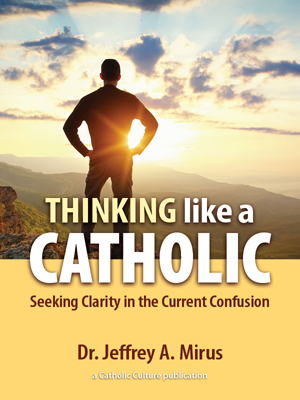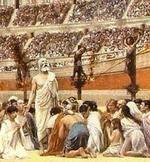REDEMPTIONIS SACRAMENTUM
By ( articles ) | Apr 26, 2004
Free eBook:

|
| Free eBook: Thinking like a Catholic |
"Father: What do you really think about the new liturgy guidelines? I assume you are aware of them. Are they good, will they work, will they make a difference. Of course, I know there are no liturgical abuses in the Diocese of Brooklyn, under your watchful eye, nor are there any in New York, Albany, Syracuse, Rochester and Buffalo, or for that matter, anywhere in the United States. There haven't been for years. If fact, there never were any abuses, just old cranks who wanted Latin and couldn't accept Vatican II. But I ramble. What's your view. Tim"
Well, it's all quite lovely, I'm sure. I just wish these liturgy documents would specify the planet to which they refer.
What strikes me most is the absence of any sense of crisis, beautifully captured in section four of the Preamble, the unintentionally hilarious quote from the Holy Father: "Certainly the liturgical reform inaugurated by the Council has greatly contributed to a more conscious, active, and fruitful participation in the Holy Sacrifice of the Altar on the part of the Faithful" (Ecclesia de Eucharistia). There is a disconcerting disconnect from the observable situation evident in that sentence.
The "liturgical reform" of the Second Vatican Council produced nothing like the renewal of the Church hoped for, and predicted, by the scholars of the Liturgical Movement of the early twentieth century. In the United States, we have had a Mass attendance decline of more than sixty percent in thirty years. In my Diocese of Brooklyn, Mass attendance was at 18% a couple of years ago; in New York, 19%; in Chicago, 16% -- and these figures were recorded before the clerical sex abuse crisis. The collapse of the Church in her previous bastions of the Netherlands and Quebec, the situation in Western Europe: all of this is well known. Yet we are determinedly told that this is an age of renewal -- an age of MORE active, fruitful liturgical participation.
There is no sense of crisis in this document. Reading it, one gets the impression that things are, in general, flourishing, with a few details in need of fine-tuning. Certainly, I read nothing that reflects the situation I hear from in the letters, emails and calls I've received from thoroughly exasperated Catholics across the nation, people who want to find a parish where the liturgy is celebrated reverently, the Gospel faithfully preached and devotions fostered. This disconnect is unfortunate. It puts great pressure on Faithful people. Liturgical worship should be renewing and refreshing; instead, it is frustrating for many people sitting in the pews watching Father Bob and the musicians expressing themselves on the altar.
To speak just for myself: Chapter three, section 128 of this well-meaning document tells me that, as a Priest, I should concelebrate or assist in choir (cassock and surplice) when present at Mass. It is "not fitting" for me to "participate at Mass... in the manner of the lay Faithful." Well, frankly, I avoid concelebration outside of my parish as much as possible. It is painfully distracting to be on the altar and be implicated in the slovenly, irreverent things that happen during Mass in most places. I am much better off in the pews, half-way down the nave, the distance from Father Bob and the Head Woman in her alb crooning a psalm into the microphone helping me immensely to be able to pray, or at least not smoulder in resentment. Whoever wrote section 128 doesn't have to deal with that on a regular basis.
And, of course, there's chapter three, section 59, referring to the "reprobated" practice of Priests altering liturgical texts. "...in doing this, they render the celebration of the Sacred Liturgy unstable." Really? So I'm actually supposed to say, for example, "Look with favor on your church's offering, and see the victim whose death has reconciled us to yourself (Eucharistic Prayer III)," questionably grammatical as it is? Or, another favorite, "We are to show to those in need your goodness to ourselves (Lenten Preface III)." The competent authorities have not even given us worthy vernacular liturgical books (and don't get me started on the new, multi-volumed Lectionary!), yet somehow there is something sacred about the grammatical errors in texts vouchsafed us by ICEL and the bishop's conference.
Another noteworthy deficiency of this document is its treatment of liturgical music. Chapter three section 57 calls briefly for "true and suitable sacred music." In a document on liturgical abuses, I would suggest that sacred music should have been a major, emphasized point. The preservation of the Church's liturgical music patrimony was a goal clearly expressed by the Second Vatican Council: the fostering of Gregorial chant was an absolute directive of that Council and subsequent Popes. The Holy Mass has been transformed in many places into a kind of sanctified karaoke hour; the phenomenon of the consecrated camp-fire songs we find in many if not most parishes was a big factor in completely changing peoples' approach to the Liturgy. Indeed, nothing so contributed to the transformation of Catholic liturgy into the tawdry, cheesy reality so often encountered today as the abandonment of our sacred music. The Mass is now a vehicle for self-expression, as every priest with a youth group, or who has tried to uphold liturgical reverence during a Funeral or Wedding, knows all too well. The sense of the Liturgy as something we reverently receive, as a treasure, from those who have gone before us -- literally, the "tradition," that which is handed on -- has been profoundly weakened. And the Holy See's recent concern about "inclusive language" liturgical texts is persistently undermined by the rewriting of hymn texts which even avoid referring to Christ as "He."
I am troubled by the absence of a sense of crisis in this document. It was written for a well-ordered Church which does not exist. It determinedly avoids dealing with the fact that there is widespread disobedience in the Church, and this document itself will fall on deaf ears for that reason. At some point, someone is going to need to say, "Hey, guys, we have a problem here and it needs FIXING."
A very well-known Priest-author once said to me, "The Constitution on the Sacred Liturgy (of Vatican II) was to liturgical reform what the Enola Gay was to urban renewal." That was more than just a clever comment: it was a wise, practical observation. When do we get a document that reflects that reality?
All comments are moderated. To lighten our editing burden, only current donors are allowed to Sound Off. If you are a current donor, log in to see the comment form; otherwise please support our work, and Sound Off!






